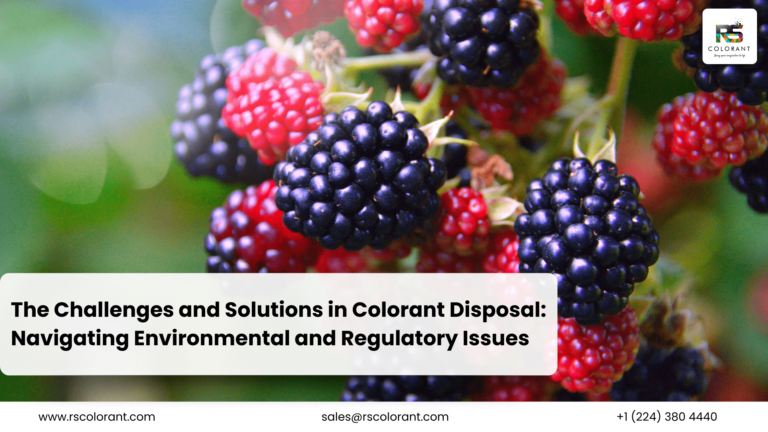The Role of Colorants in the Food and Beverage Industry
Introduction
Have you ever wondered why your favorite drinks and snacks look so vibrant and appealing? The secret lies in the colorants used in the food and beverage industry. Color plays a crucial role in our perception of food, influencing our taste, preferences, and overall experience. Let’s dive into the fascinating world of food colorants and explore their significance in our daily lives.
Historical Background of Food Colorants
Colorants in food have a long history. Ancient civilizations used natural ingredients like turmeric, saffron, and beetroot to add color to their dishes. With the industrial revolution came the development of synthetic colorants, which offered a broader spectrum of colors and improved consistency.
Types of Food Colorants
Natural Colorants
Natural colorants are derived from plants, animals, and minerals. Examples include:
- Carotenoids (from carrots and tomatoes)
- Anthocyanins (from berries and grapes)
- Chlorophyll (from leafy greens)
Artificial Colorants
Artificial colorants are chemically synthesized to provide vibrant and stable colors. Some common artificial colorants include:
- Tartrazine (yellow)
- Allura Red (red)
- Brilliant Blue (blue)
Nature-Identical Colorants
Nature-identical colorants are chemically synthesized to mimic the properties of natural colorants. They offer a balance between natural and artificial colorants, providing consistency and safety.
Natural Colorants
Sources of Natural Colorants
Natural colorants come from various sources:
- Plants: Turmeric, spinach, beets
- Animals: Cochineal insects (for carmine)
- Minerals: Titanium dioxide (for white)
Benefits of Natural Colorants
- Health Benefits: Rich in antioxidants and nutrients
- Eco-Friendly: Sustainable and biodegradable
- Consumer Appeal: Preferred by health-conscious consumers
Challenges of Using Natural Colorants
- Stability: Susceptible to changes in light, heat, and pH
- Cost: Often more expensive than synthetic options
- Availability: Limited supply depending on the source
Artificial Colorants
Common Artificial Colorants Used
Artificial colorants are widely used due to their vibrant colors and stability. Some commonly used ones are:
- Tartrazine (Yellow 5)
- Allura Red (Red 40)
- Brilliant Blue (Blue 1)
Advantages of Artificial Colorants
- Consistency: Uniform color across batches
- Cost-Effective: Cheaper to produce and use
- Wide Range: Available in many shades and hues
Concerns and Controversies
Artificial colorants have been linked to health concerns such as hyperactivity in children and potential carcinogenic effects. Regulatory bodies closely monitor their use to ensure safety.
Regulation and Safety of Food Colorants
Regulatory Bodies and Guidelines
Food colorants are regulated by agencies like the FDA (Food and Drug Administration) in the USA and EFSA (European Food Safety Authority) in Europe. These bodies set guidelines for acceptable daily intake and ensure safety through rigorous testing.
Testing and Approval Process
Colorants undergo extensive testing for toxicity, carcinogenicity, and other health effects. Only those meeting strict safety standards are approved for use in food and beverages.
Consumer Safety Considerations
Consumers are advised to check labels for colorant information and stay informed about potential risks. Choosing products with natural colorants can be a safer option for those with sensitivities or health concerns.
Colorants in the Beverage Industry
Popular Colorants in Beverages
Beverages often use colorants to enhance visual appeal. Popular choices include:
- Caramel color in colas
- Anthocyanins in fruit juices
- Turmeric in health drinks
Impact on Consumer Preferences
The color of a beverage can significantly influence consumer preferences. Bright, appealing colors can make a product more attractive and increase its marketability.
Case Studies of Successful Beverage Colorations
Brands like Pepsi and Coca-Cola have successfully used colorants to create iconic products. For example, the distinctive caramel color of colas is a key part of their brand identity.
Colorants in the Food Industry
Common Applications in Food Products
Colorants are used in a variety of food products, including:
- Baked Goods: Frostings and dough
- Dairy Products: Yogurts and cheeses
- Confectionery: Candies and chocolates
Enhancing Visual Appeal and Marketability
Adding color to food can enhance its visual appeal, making it more appetizing and marketable. Brightly colored foods are particularly popular among children and can influence purchasing decisions.
Examples from Various Food Categories
- Snacks: Chips and crackers with added color
- Breakfast Cereals: Vibrant hues to attract kids
- Sauces and Condiments: Enhanced color for visual appeal
Health Implications of Food Colorants
Potential Health Benefits of Natural Colorants
Natural colorants can offer health benefits due to their nutrient content. For example, carotenoids have antioxidant properties that can support eye health.
Risks Associated with Artificial Colorants
Artificial colorants have been associated with health risks, including:
- Hyperactivity in children
- Allergic reactions
- Potential carcinogenic effects
Current Research and Findings
Ongoing research continues to explore the health impacts of colorants. Recent studies emphasize the need for cautious use of artificial colorants and suggest further investigation into their long-term effects.
Innovations in Food Coloring
Advances in Natural Colorant Extraction
New techniques are being developed to improve the extraction of natural colorants, making them more stable and cost-effective.
Sustainable and Eco-Friendly Colorants
The industry is moving towards sustainable practices, including the use of eco-friendly colorants derived from renewable sources.
Future Trends in Food Coloring
Future trends include the use of bioengineered colorants and innovative applications in plant-based and functional foods.
Consumer Perception of Food Colorants
Importance of Color in Consumer Choices
Color plays a crucial role in consumer choices, affecting perceptions of taste, quality, and freshness.
Trends in Consumer Preferences
Consumers are increasingly seeking natural and clean-label products, driving demand for natural colorants.
Marketing Strategies Involving Color
Brands use color strategically in marketing to create visual appeal and convey specific messages, such as health and freshness.
Colorant Labeling and Transparency
Importance of Clear Labeling
Clear labeling helps consumers make informed choices and understand the ingredients in their food.
How to Read and Understand Colorant Labels
Learning to read colorant labels can help consumers identify natural and artificial colorants and make healthier choices.
Industry Practices for Transparency
The industry is adopting more transparent practices, including clear labeling and communication about the sources and safety of colorants.
Case Studies of Colorant Usage
Successful Brands Using Innovative Colorants
Brands like Starbucks and Nestlé have successfully used innovative colorants to enhance their products and appeal to health-conscious consumers.
Lessons from Industry Leaders
Industry leaders demonstrate the importance of innovation, transparency, and consumer engagement in the successful use of colorants.
Real-World Examples
Real-world examples illustrate how effective colorant usage can enhance product appeal and drive sales.
Future of Food and Beverage Colorants
Emerging Technologies
Emerging technologies in colorant production and application promise to revolutionize the industry.
Predicted Market Trends
Market trends indicate a growing preference for natural and clean-label colorants, driven by consumer demand for healthier options.
Potential Challenges and Opportunities
The industry faces challenges such as regulatory changes and supply chain issues but also opportunities for innovation and growth.
Conclusion
Colorants play a vital role in the food and beverage industry, enhancing the visual appeal and marketability of products. While natural colorants offer health benefits and eco-friendliness, artificial colorants provide consistency and cost-effectiveness. As consumer preferences shift towards natural and transparent products, the industry must continue to innovate and adapt to meet these demands.
FAQs
What are natural food colorants? Natural food colorants are derived from plant, animal, or mineral sources and are used to add color to food and beverages.
Are artificial colorants safe to consume? Artificial colorants are generally considered safe when used within regulatory limits, but some studies have raised concerns about potential health risks.
How do colorants affect the taste of food? While colorants primarily affect the appearance of food, they can also influence perceived taste by enhancing visual appeal.
Why is color important in food marketing? Color is crucial in food marketing as it can attract consumers, convey brand identity, and influence perceptions of taste and quality.
What are the latest trends in food colorants? Latest trends include the use of natural and clean-label colorants, sustainable practices, and innovations in bioengineered colorants.




